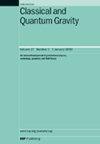利用下一代引力波观测站探测宇宙化学富集情况
IF 3.6
3区 物理与天体物理
Q2 ASTRONOMY & ASTROPHYSICS
引用次数: 0
摘要
通过观察双黑洞(BBH)合并到宇宙边缘,下一代(XG)地面引力波探测器,如宇宙探索者和爱因斯坦望远镜,将绘制出整个宇宙历史上的BBH合并率。这个合并率是它们的祖先恒星的形成率与延迟时间分布的卷积。考虑到延迟时间分布的理论先验,我们展示了XG观测如何测量BBH祖细胞形成速率,探测恒星形成速率(SFR)高达z bbb15。然而,祖细胞形成速率并不能直接测量SFR,而是SFR及其金属丰度分布作为红移函数的组合。幸运的是,BBH形成的金属依赖性可能随着BBH质量和/或形成通道的变化而变化。我们发现,如果可以识别出具有不同金属丰度偏差的不同BBH亚群,将它们的速率作为红移的函数进行比较,可以同时测量SFR及其金属丰度分布。考虑到乐观的理论先验和一年的观察,这可能会提供峰值SFR的测量值,以及0.2指数(0.7指数)的中位金属丰度测量值,直到z = 10 (z = 15),可信度为90%,尽管不确定性尺度与BBH延迟时间和地层效率的理论不确定性有关。本文章由计算机程序翻译,如有差异,请以英文原文为准。
Probing cosmic chemical enrichment with next-generation gravitational-wave observatories
By observing binary black hole (BBH) mergers out to the edge of the Universe, next-generation (XG) ground-based gravitational-wave detectors like Cosmic Explorer and Einstein Telescope will map the BBH merger rate across all of cosmic history. This merger rate traces the formation rate of their progenitor stars convolved with a delay time distribution. Given theoretically-motivated priors on the delay time distribution, we show how XG observations can measure the BBH progenitor formation rate, probing the star formation rate (SFR) up to z > 15. However, the progenitor formation rate does not directly give a measurement of the SFR, but rather a combination of the SFR and its metallicity distribution as a function of redshift. Fortunately, the metallicity-dependence of BBH formation likely varies as a function of BBH mass and/or formation channel. We find that if different BBH subpopulations with distinct metallicity biases can be identified, comparing their rates as a function of redshift yields a simultaneous measurement of the SFR and its metallicity distribution. Given optimistic theoretical priors and one year of observation, this may provide a measurement of the SFR at its peak and a 0.2 dex (0.7 dex) measurement of the median metallicity out to z = 10 (z = 15) at 90% credibility, although the uncertainties scale with theoretical uncertainties on BBH delay times and formation efficiencies.
求助全文
通过发布文献求助,成功后即可免费获取论文全文。
去求助
来源期刊

Classical and Quantum Gravity
物理-天文与天体物理
CiteScore
7.00
自引率
8.60%
发文量
301
审稿时长
2-4 weeks
期刊介绍:
Classical and Quantum Gravity is an established journal for physicists, mathematicians and cosmologists in the fields of gravitation and the theory of spacetime. The journal is now the acknowledged world leader in classical relativity and all areas of quantum gravity.
 求助内容:
求助内容: 应助结果提醒方式:
应助结果提醒方式:


